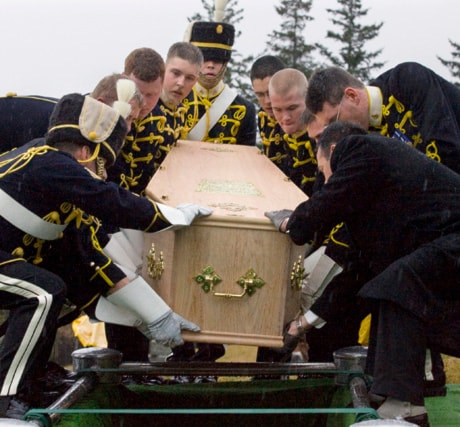HAMMONDVALE, N.B. — More than 90 years after she died and her remains were inexplicably forgotten in storage in a London catacomb, Gladys Fowler is finally home in Canada.
On Sunday, during a service on a hillside in Hammondvale, N.B., Fowler was laid to rest in a grave where relatives believed she had been all along.
“It’s a sad day because a young girl has died, and a young girl has died very far from home, and didn’t return until this day,” said Fowler’s niece, Jane Fowler Morse.
Fowler died on April 17, 1917 at the age of 18 at the Berners Hotel in London.
She was the daughter of then-New Brunswick MP George Fowler, at the time a lieutenant-colonel serving with the 13th Canadian Reserve Battalion during the final months of the First World War.
A death certificate lists her cause of death as a combination of heart disease and illness.
Her coffin was placed in a packing crate and stored in a huge catacomb beneath the Anglican Chapel at Kensal Green Cemetery — apparently for later transport to Canada — but that didn’t happen until now.
Even now, Morse said no one knows why her aunt was left behind.
“Our grandfather did suffer financial losses in a big fire in Sussex in the early 1920s and he was ill when he came back from the war and he died in 1927, so whether those interfered, or something else, it’s hard to say.”
Barry Smith of the Friends of Kensal Green Cemetery traced her story after cemetery officials decided to open the mysterious packing crate that had been left among the 2,500 coffins that inhabit the catacomb.
Inside they discovered the coffin bearing a plaque with Fowler’s name engraved.
That led Smith to trace the death certificate and begin a search for family members in an effort to solve the mystery.
Morse, of Geneseo, N.Y., came forward after hearing the story.
She said her father, Cedric, often spoke fondly of his sister, but never mentioned that she wasn’t buried in the family plot, despite the fact that her name was engraved on the large granite headstone there.
Fowler’s father died in 1924 and her mother died in 1936, while a brother named Eric died at the age of 30 in 1930.
Morse’s father died in the United States where he had emigrated, and his body was donated to science.
“A wound was closed for our family today, and I’m certainly grateful for that,” said Morse’s brother John Fowler of Wrightstown, Penn.
Eight members of the 8th Canadian Hussars strained under the weight of the lead-lined coffin as they carried it up a wet, grassy hill to the grave site.
A few dozen members of the rural community stood in the pouring rain to attend the service and show their support for the Fowler family.
“The family has always been well thought of,” said Ruth Floyd.
“Gladys’s father donated this land for the cemetery, and the land for the church and the school.”
Following the service Fowler and Morse thanked the many people for the outpouring of donations that resulted in his aunt’s final trek home.
Those donations included the flight by Air Canada and services of the Wallace Funeral Home in Sussex, N.B.
“I’m humbled by the Canadian people and the outpouring of support,” Fowler said as he choked back tears. “It makes us proud to have Canadian roots.”
Fowler and Morse made a special point to thank Barry Smith who began the search into Gladys’s story, and made the trip to Canada to escort the remains to their final resting place.
“We gave her back her nationality and her identity and now we’re pleased to give her back to her family,” Smith said.
It has been a story Smith has been involved with for more than two years, and he was philosophical when asked about it coming to an end.
“It’s a story of two parts,” he said, “one, the inhumanity that caused Gladys to be in London, and the second part 92 years later is the generosity and humanity of so many people to bring her home.”
